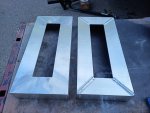Years ago, I walked into a welding store intent on getting a MIG as my first welder. But somehow I ended up walking out with a Miller EconoTIG at twice the price. From there I'm self taught. I tried stick welding with it first. I used about half a stick and said "screw this" and the rest of that pack is in a box somewhere (20 years later). I just watched a bunch of video and read a lot, and there wasn't much 20 years ago. I think I have a VHS tape somewhere... and this is where I'm at now. (was a shame to grind those, but had to so it sits flat on the floor). Maybe it's because I just don't know anything better, but I'm really happy I just went right to TIG and skipped the other processes. It takes a precise hand, attention to detail, and some knowledge of the science. But the payback is really worth it. The only disadvantage I have come across, is upside-down and out of position welding is really hard. That being said, I can weld upside down. It's just not always pretty. My BIL is a millwright who MIG welds a lot, but he can't do upside-down. That surprised me.
Not intending to humble brag, but I really don't find aluminum that hard to TIG. Even when I first tried it I thought 'what's the big deal?' I have tried MIGing aluminum at my BIL's because my machine didn't have enough power to do a 3/16" fillet weld, and just gave up immediately. That just seems hopeless because you have no control over the heat. Cold weld to start, and then burn through at the end.
For TIG, the machine makes a surprising difference. The EconoTIG is a really basic machine without much in the way of settings and controls, no balance, no square wave. I recently had to use my BIL's square wave machine, and I was surprised at how much better it was. Very pretty welds. And 250A was enough to do that 3/16" fillet when my 180A just would not. His machine is an Everlast, and so far, so good.
My latest project is all-aluminum, and it's my first. An Australian-style "touring" canopy. The only parts that are steel are where I know I need concentrated strength. ie: trailer hitch, spare tire carrier. It is true that the difference in weight between an aluminum and steel structure, if designed well, is not so great. However, I typically find I over-build, and it's easier to keep the weight down when using aluminum. But more importantly, designing/building for light weight/high strength in a home shop using materials from your local supplier is hard. They won't be stocking a lot of thin-wall high-strength steel tubing. But they all have 6061 aluminum, which is surprisingly strong compared to typical low-strength square steel tubing. And then there's 7075... That stuff is really strong. All that being said, if I had realized how much all this aluminum was going to cost... I think I estimated about $2000 but I'm probably about $5000 now. Though I think I'm getting ripped off by the low-volume suppliers.








